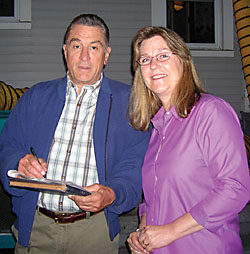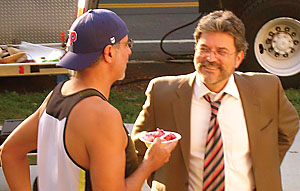 | Martha Oneppo poses with Robert DeNiro. |
The three-family Victorian-style home of Yale staff member Vincent Oneppo
will appear on the silver screen as a Queens, New York, tenement house in an
upcoming movie starring Robert DeNiro and Al Pacino. — By Susan Gonzalez
T H I S
‘Quiet on the set!’: Scenes for DeNiro-Pacino movie shot in employee’s home
That fact is not an insult to Oneppo, who says that his 1890s-era home, on Orange
Street in New Haven’s East Rock neighborhood, was dramatically transformed
for the $60 million independent film, titled “Righteous Kill.” The
movie is a thriller about a serial killer being pursued by two New York City
police officers, portrayed by DeNiro and Pacino. Most of the action filmed in
Oneppo’s home was shot in a spare bedroom.
“We had to pack away a lot our belongings because the film company brought
in new furniture and ‘dressed’ the property to give it a certain
character,” says Oneppo ’73 MUS, director of the concert and press
office at the School of Music.
The house was chosen after Oneppo’s wife, Martha Oneppo ’77 MUS,
offered up their residence in response to a flyer left by film location scouts
at several homes in the neighborhood. A location scout visited to assess the
home’s merits; this was followed by visits from a location manager, an
art director and others concerned with finding the best site for a particular
scene.
Once the home was selected, a whole new entourage came to scope out the Oneppos’ second-floor
apartment, which boasts 10-foot-high ceilings and original ?moulding. In addition
to the film’s cinematographer, this group included “Righteous Kill” director
Jon Avnet, whose directorial credits include the 1991 film “Fried Green
Tomatoes” and the 1996 movie “Up Close and Personal.”
Shortly thereafter, an art director swooped in to decide which of the Oneppos’ furniture
could be used during filming and which had to be stored away. Luckily, the couple — who
received a location fee and other expenses during filming — had room to
store the “unwanted” belongings in a large music room in the home’s
first-floor apartment. Martha, a singer, uses the room as a private-lesson teaching
studio, and Vincent, a clarinetist, practices his music there. Items the two
needed access to, such as their computer, were stored in the Oneppos’ bedroom.
This room — which was not used in the film — became the couple’s “little
sanctuary” during the several days that the house was being prepared for
filming, says Oneppo.
“The ‘set dressing,’ as they called it, happened during the
first week of Yale classes — the worst possible week for me in terms of
work responsibilities,” recounts Oneppo. “But it was fascinating
to watch the process. For example, the production team only wanted understated
art on the walls — images that wouldn’t divert viewers’ attention
from the action — and liked this one painting that Martha and I had gotten
at a tag sale some 20 years ago. Ultimately, however, the picture had to removed,
as we could not identify the artist, and the crew would have had to get permission
to use the painting in the scene. It was amazing to see that that level of detail
goes into creating a movie.”
Oneppo was pleased, however, to have two of his own paintings — one of
East Rock and one a scene of a Guilford field — chosen as props for the
film.
In addition to bringing in new furniture to “dress” the space, the
Oneppos’ spare bedroom was wallpapered, and at the front entrance of the
house, scaffolding was erected and then draped with black cloth to create the
illusion of nighttime.
“It was very strange to have this dark shroud around us during the beautiful
weather of Labor Day weekend,” recalls Oneppo.
During the actual filming following the holiday weekend, the Oneppos stayed at
a local hotel, but they were given the privilege of being near the filming action
from time to time.
“Martha was able to poke around while they filmed a few scenes and, while
I got to see less of it, I was able to observe some,” says Oneppo. “I
learned a lot, particularly how hard the crew works. For a scene that is probably
two to three minutes in a movie, it is shot over and over and over again from various angles. It’s pretty incredible to watch.”

Vincent Oneppo (right) chats with director Jon Avnet during the filming in his New Haven home.
The Oneppos also had the chance to see DeNiro (who was whisked in and out of
their home to avoid fans gathered outside), as well as Carla Gugino (who plays
DeNiro’s love interest in the film) and DeNiro’s double. Martha,
in fact, had the opportunity to speak to DeNiro; his double told her to draw
DeNiro’s attention by telling the actor that she is the homeowner.
“DeNiro was very cordial to her,” says Oneppo, who did manage to
engage in a few conversations with Avnet, whom he also found to be very sociable.
“I complimented the whole production crew on its respectful attitude toward
our property and that of our neighbors,” says Oneppo. “We were worried
about the impact of this on the neighborhood, and made sure that the production
company contacted our neighbors and compensated them if warranted, such as when
their driveways were used.” A “sophisticated communication” system
between the production crew and the New Haven police allowed the police to quickly
close down and re-open the street, limiting the disruption.
Oneppo’s favorite aspect of the production was talking to those who work
in the background on a film production, including the painters and electricians. “I
got some advice on electrical work and paint colors for the walls,” he
comments.
After the filming ended, members of the design crew, called “scenics,” then
had to restore the Oneppos’ property to its original state, a process that
included the removal of the bedroom wallpaper they had only recently installed.
The filming at his house marked the second time this summer that Oneppo has gotten
to feel close to the action during filming with major movie stars. During the
filming in New Haven of the fourth installment of “Indiana Jones,” Oneppo
helped one of the designers size and place posters in display cases outside of
Sprague Memorial Hall. The posters featured Alfred Hitcock’s 1957 film “Vertigo” — in
keeping with the 1950s setting of the film.
“I also got to see Harrison Ford’s double and later, Harrison Ford,
as a chase scene was filmed outside of Sprague Hall. It seemed the same chase
took place 100 times a day on College Street,” Oneppo remembers.
Stephanie Schwartz, associate secretary of the University and its director of
marketing and trademark licensing, says that the state’s tax incentives
for filmmakers as well as the attractiveness of New Haven may make film crews
a common sight for Yale staff and students.
“The uptick in filming activity around New Haven will create an array of
opportunities for members of the Yale community to get up close and personal
with the movie-making process — and a chance to see themselves, their community
and even (as in Vinnie’s case) their houses — on the ‘Big Screen,’” comments
Schwartz.
More scenes from “Righteous Kill,” including those featuring Pacino,
were filmed in other Connecticut cities, among them nearby Milford.
Oneppo has to wait for about a year to see “Righteous Kill,” and
he eagerly awaits that opportunity.
“The scene shot in my house will likely last about four or five minutes,” he
says. “I look forward to seeing the setting — and my paintings — on
the silver screen.”  W E E K ' S
W E E K ' S S T O R I E S
S T O R I E S![]()
 Yale, Peru forge ‘model’ collaboration on Machu Picchu
Yale, Peru forge ‘model’ collaboration on Machu Picchu![]()
![]()
 Foster + Partners to design new SOM building
Foster + Partners to design new SOM building![]()
![]()
 NIH grant aims to speed development of alcoholism treatment
NIH grant aims to speed development of alcoholism treatment![]()
![]()
 ‘Quiet on the set!’: Scenes for DeNiro-Pacino movie shot in employee’s home
‘Quiet on the set!’: Scenes for DeNiro-Pacino movie shot in employee’s home![]()
![]()
 ENDOWED PROFESSORSHIPS
ENDOWED PROFESSORSHIPS
 Anderson comes to Yale as Lanman Professor
Anderson comes to Yale as Lanman Professor![]()
 Harries appointed as first Ragen Professor
Harries appointed as first Ragen Professor![]()
 Nägele is first incumbent of Mohr Professorship
Nägele is first incumbent of Mohr Professorship![]()
 Smith has been named to Wells Professorship
Smith has been named to Wells Professorship![]()
![]()
 Scholars named to joint posts at MacMillan Center
Scholars named to joint posts at MacMillan Center![]()
![]()
 Abigail Rider to manage Yale’s real estate
Abigail Rider to manage Yale’s real estate![]()
![]()
 Exhibit chronicles slavery and emancipation in Jamaica
Exhibit chronicles slavery and emancipation in Jamaica![]()
![]()
 Activist and author Gloria Steinem to visit as Chubb Fellow
Activist and author Gloria Steinem to visit as Chubb Fellow![]()
![]()
 Art, music of Tibetan monks to be featured in campus events
Art, music of Tibetan monks to be featured in campus events![]()
![]()
 Architect-designed housewares produced by Swid Powell . . .
Architect-designed housewares produced by Swid Powell . . .![]()
![]()
 Award-winning play about conjoined twins to be presented
Award-winning play about conjoined twins to be presented![]()
![]()
 Brownell: Food addiction and nutrition
Brownell: Food addiction and nutrition![]()
![]()
 Part one of two-part conference will explore ‘Frontier Cities’
Part one of two-part conference will explore ‘Frontier Cities’![]()
![]()
 Tribute to Cleanth Brooks examines the topic ‘What is Close Reading?’
Tribute to Cleanth Brooks examines the topic ‘What is Close Reading?’![]()
![]()
 Show features paintings of city scenes by Constance LaPalombara
Show features paintings of city scenes by Constance LaPalombara![]()
![]()
 Getting saucy
Getting saucy![]()
![]()
 Look at ‘Past Year in Admissions’ . . .
Look at ‘Past Year in Admissions’ . . .![]()
![]()
 Campus Notes
Campus Notes![]()
Bulletin Home |
| Visiting on Campus
Visiting on Campus |
| Calendar of Events
Calendar of Events |
| In the News
In the News![]()
Bulletin Board |
| Classified Ads
Classified Ads |
| Search Archives
Search Archives |
| Deadlines
Deadlines![]()
Bulletin Staff |
| Public Affairs
Public Affairs |
| News Releases
News Releases |
| E-Mail Us
E-Mail Us |
| Yale Home
Yale Home